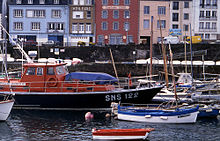Douarnenez
| Douarnenez | ||
|---|---|---|

|
|
|
| region | Brittany | |
| Department | Finistère | |
| Arrondissement | Quimper | |
| Canton | Douarnenez (main town) | |
| Community association | Douarnenez Communauté | |
| Coordinates | 48 ° 6 ′ N , 4 ° 20 ′ W | |
| height | 0-86 m | |
| surface | 24.94 km 2 | |
| Residents | 13,902 (January 1, 2017) | |
| Population density | 557 inhabitants / km 2 | |
| Post Code | 29100 | |
| INSEE code | 29046 | |
| Website | http://www.douarnenez.fr/ | |
 The Douarnenez quay |
||
Douarnenez is a commune in western France in the Finistère department in Brittany .
geography
Douarnenez is located in the west of the historic Cornouaille region , about 25 kilometers northwest of Quimper , at the mouth of the Pouldavid estuary on the south bank of the Bay of Douarnenez. The municipality has 13,902 inhabitants (as of January 1, 2017) and an area of 24.94 km². The rocky island île Tristan lies in front of Douarnenez .
history
Due to its sheltered location, the place was already used by the Romans as a port before the difficult passage into Britain. In addition, here was garum made, a fish sauce that was used throughout the Roman Empire for seasoning food.
Over the centuries the city developed into an important fishing port. Almost all men and boys went fishing in single-masted boats; the average crew consisted of three men. There were several hundred boats that put to sea at the same time and hoisted their sails, mostly red-brown colored with tan. The crews stayed at sea for several days, depending on the fishing opportunities, and then lived on a piece of bread, water they had taken with them and bycatch that was cooked on a small stove in the boat. In the sun, wind or rain they only protected canvas clothing, pants and a wide top, some of which, like the sails themselves, had been made waterproof with tree resin. Not all had wooden shoes, many were barefoot. The traditional fish marketed in the factories were tuna and sardine . The fishing was supplemented by meager agriculture (cabbage, potatoes, grain) on very small plots.
In 1641 the Jesuit priest Julien Maunoir carried out his first mission in Douarnenez.
Douarnenez prospered in the 19th century, when the invention of the tin allowed fish to be sold in distant regions. The most important role was played by the sardine, on whose canned food there was a French monopoly. By the middle of the century, 40 fish factories had settled in the city, in which mainly women and girls found work. When the swarms of sardines suddenly stopped coming around 1880, this led to a depression with poverty and mass unemployment. The female population tried to earn a living with bobbin and crochet work , which were commissioned by factories, others intensified the artisanal production of iodine blocks from algae (in well-designed ovens that are still present on the coastline today) which were then sold to pharmaceutical factories. With new fishing techniques, larger boats and thanks to the fact that after 20 years the schools of sardines returned to the coast, the fishing industry was able to recover. Today Douarnenez is the sixth most important fishing port in France. There is still one of the old fish canning factories that also sells its gourmet sardines in Germany.
The identification of the home port on the boat hulls is "DZ".
In “Port Rhu”, which is partially artificially kept under flood, there is a museum on the topics of local fishing and maritime trade history, wooden sailing work ships, and the international development in boat building, from dugout canoes to deep sea sailing ships. International sailing ship meetings took place in the 1990s.
Population development
| year | 1962 | 1968 | 1975 | 1982 | 1990 | 1999 | 2006 | 2017 |
| Residents | 19,887 | 19,705 | 19.096 | 17,653 | 16,457 | 15,827 | 15,608 | 13,902 |
| Sources: Cassini and INSEE | ||||||||
economy
Douarnenez is a fishing port . In the past, mainly sardines and tuna were fished - today also mackerel , cod , rays , Johns fish , lobsters , spider crabs and scampi . The municipality also has seaside resorts (Tréboul and others) and is a sailing center. Tourists are mainly attracted by the thalasso therapy offered here and the romantic high coastal paths.
Attractions
See also: List of Monuments historiques in Douarnenez
The sights of Douarnenez include the 16th century church of Saint-Herlé in Ploaré with a Gothic tower (1548–86) and the chapels of Saint-Michel (built 1663–68), Sainte-Hélène (17th century; in the 18th century). Century significantly rebuilt) and Sainte-Croix (17th century).
Personalities
- Émile Chevé , music theorist and music teacher
- Bob Sinclar , French house DJ and producer
- Jérémy Kapone , French actor
- Jérémy Bescond , French cyclist
literature
- Le Patrimoine des Communes du Finistère. Flohic Editions, Volume 1, Paris 1998, ISBN 2-84234-039-6 , pp. 401-415.
Web links
- Website of the municipality (French)

